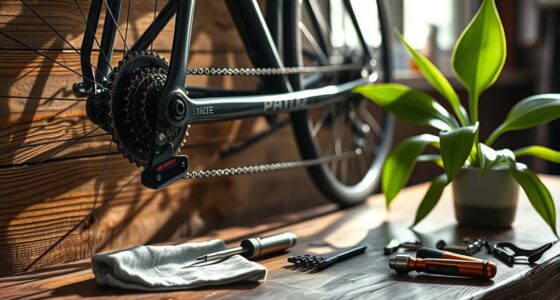To master the bunny hop solo, focus on understanding proper technique, including coordinated pull-ups, tucks, and smooth body movements. Practice on safe, flat terrain with a well-maintained bike, gradually increasing height and distance as your confidence grows. Pay attention to timing, rhythm, and body position, and use your arms and legs effectively for power. Consistent, mindful practice builds muscle memory and control. If you keep at it, you’ll discover all the tips to hopping confidently on your own.
Key Takeaways
- Focus on mastering timing, rhythm, and flow through consistent practice, listening to bike cues and body signals.
- Break down the technique into small steps: pull handlebars, lift front wheel, shift weight back, then lift rear wheel.
- Maintain proper body position—centered weight, relaxed arms, engaged core—and coordinate arm and leg movements for power.
- Practice on safe, flat terrain with clear, obstacle-free surfaces to build confidence and refine technique gradually.
- Use self-assessment and repetition to develop muscle memory, ensuring smooth, fluid hops without needing a coach.
Understanding the Basics of a Bunny Hop
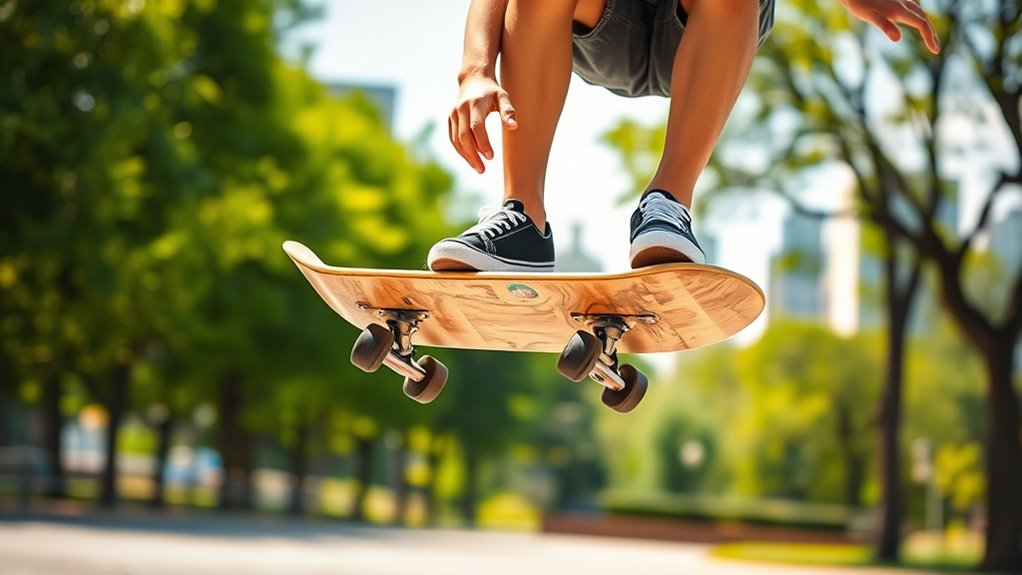
Have you ever wondered what makes a bunny hop effective? It all comes down to understanding the bunny hop mechanics and mastering the fundamental techniques. To start, you need to coordinate your body movements—pull up on your handlebars as you simultaneously lift your front wheel. Then, shift your weight back, engaging your legs to lift both wheels off the ground. Proper technique involves a smooth, fluid motion rather than jerking or rushing. Focus on timing your pull and lift, keeping your eyes ahead, and maintaining balance throughout. Small adjustments in your body position can make a huge difference in control. Practicing these basic mechanics will build your confidence and set a solid foundation for more advanced tricks. Remember, mastering the basics is key to flawless bunny hops, and understanding the mechanics of the bunny hop can help you improve more quickly. Developing a good sense of body coordination is essential for executing a clean bunny hop every time. Additionally, paying attention to your bike balance during practice can enhance your overall control. Incorporating consistent practice routines will reinforce muscle memory and improve your technique over time. Consistent practice and understanding the fundamentals of bike control are crucial in becoming proficient at bunny hops.
Preparing Your Bike and Gear
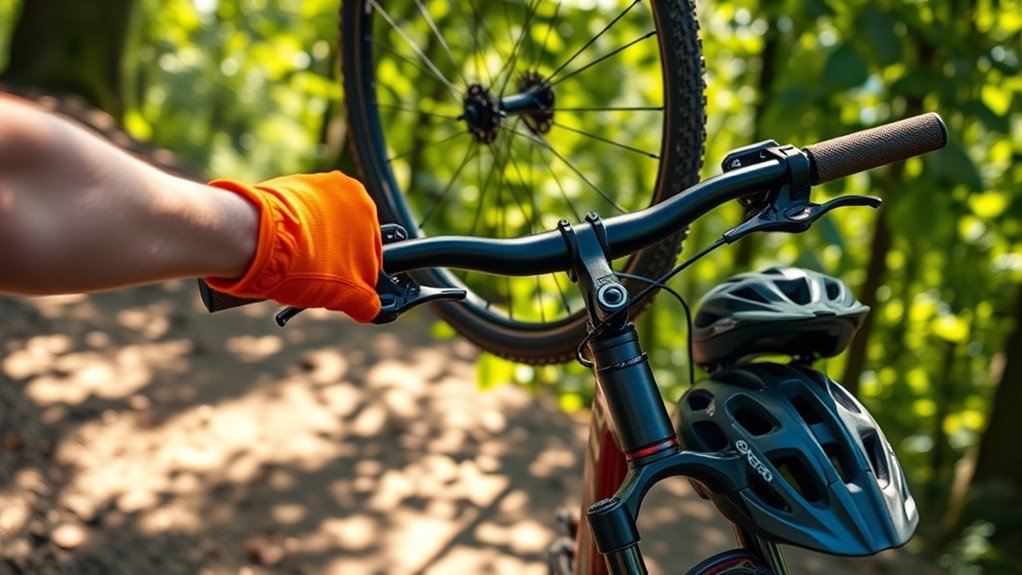
Before attempting a bunny hop, you need to make sure your bike and gear are properly prepared. Start with bike maintenance: check tire pressure, brake function, and gear shifting to ensure everything runs smoothly. A well-maintained bike makes executing the hop easier and safer. Next, consider gear selection; wear comfortable clothing and protective gear like a helmet, gloves, and pads. Proper footwear with good grip will help you control your bike better during the hop. Adjust your saddle height so you can easily pull up the front wheel. Ensuring your bike is in top shape and your gear is suitable will give you confidence and control, setting a solid foundation for mastering the bunny hop. Additionally, understanding bike maintenance and how it affects performance can help prevent issues during your ride. Developing a good sense of balance and coordination is crucial for executing the bunny hop successfully, and practicing these skills can improve your overall riding ability. Being familiar with existential themes can also boost your mental readiness and focus during practice. Regular practice and patience are essential to develop the coordination and timing needed for the bunny hop.
Finding the Right Spot to Practice
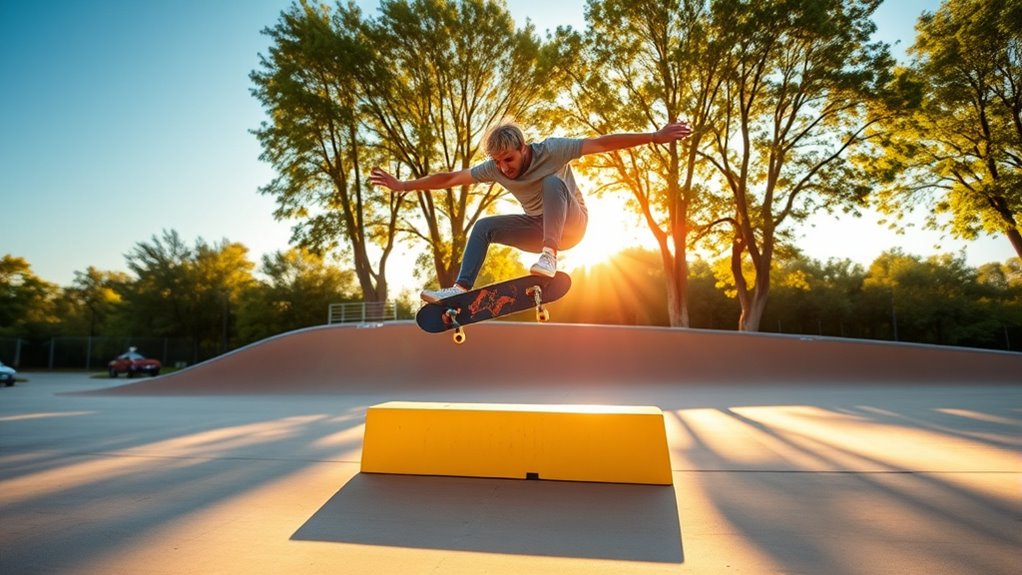
You should look for a spot with safe, stable terrain to practice your bunny hop. Find a level surface free of obstacles and loose debris to build your confidence. Picking the right location helps you focus on your technique without unnecessary risks. Additionally, choosing an area with appropriate footing can prevent slips and falls during practice. Ensuring the space allows for efficient navigation can also help your progress as you refine your movements. Selecting a location with consistent surface conditions can further support steady skill development. Incorporating areas with varied terrain can also help improve your adaptability and control during jumps. Being aware of environmental factors such as weather and lighting can also enhance your safety and focus while practicing.
Choose Safe Terrain
Choosing the right terrain is essential for practicing the bunny hop safely and effectively. Look for a spot with minimal trail hazards like loose rocks or roots, which can cause falls or misjudgments. Weather considerations also matter—avoid muddy or wet surfaces that can reduce traction or make landing unpredictable. Opt for a smooth, dry area with a gentle incline if possible. To help visualize, consider this:
| Ideal Terrain Features | Avoid These Hazards |
|---|---|
| Flat, smooth surface | Loose gravel or uneven ground |
| Dry conditions | Muddy, wet patches |
| Clear space for landing | Overgrown or obstructed areas |
| Mild incline for control | Sharp drops or steep slopes |
| Well-lit area | Low visibility zones |
Prioritize safety to build confidence and prevent accidents. Additionally, choosing a safe terrain can help you focus on technique without unnecessary risk. Being aware of trail hazards is also crucial for maintaining safety during practice. Recognizing terrain features that support safe riding can make a significant difference in your progress. Incorporating awareness of vibrational energy can also help you stay focused and positive while practicing. Understanding macronutrient ratios in your diet can contribute to better overall energy levels and endurance during training sessions.
Find Level Surfaces
Finding a level surface is key to practicing the bunny hop safely and effectively. Look for flat ground free of debris, roots, or uneven patches that could cause instability. A smooth, open area allows you to focus on your technique without distractions. When choosing a spot, consider:
- Nearby trail obstacles for realistic practice scenarios
- Good bike maintenance to ensure smooth handling
- Enough space to land safely and regain control
Avoid slopes or uneven terrain, which can make executing the bunny hop more difficult and risky. Consistent practice on level surfaces builds confidence and muscle memory. Additionally, selecting a retail hours location with flexible hours can help you find the best time to practice without rush or interruption. Once you’ve mastered the move on flat ground, you’ll be better prepared to handle more complex trail obstacles confidently and safely.
Building the Necessary Body Position
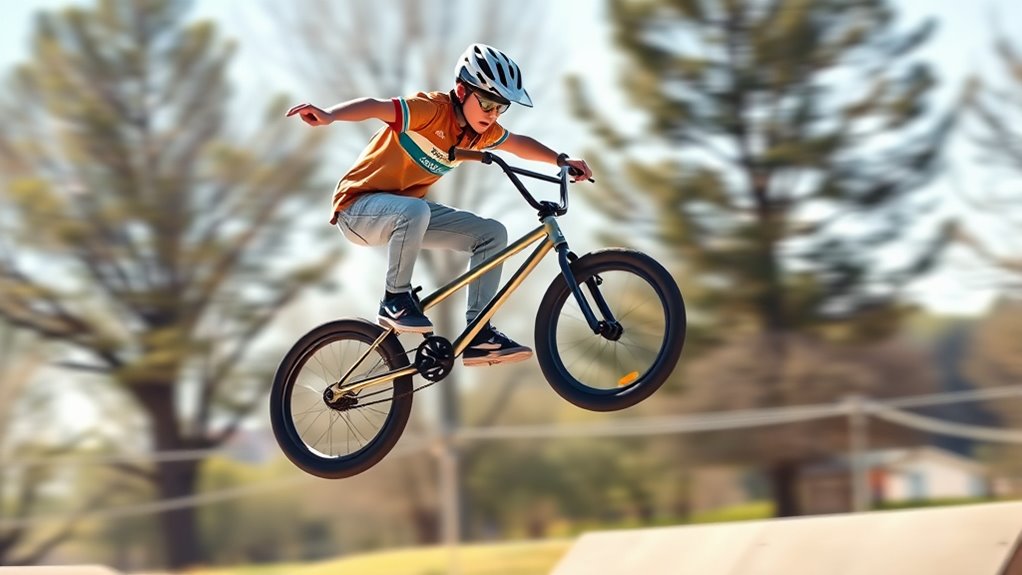
To successfully perform the bunny hop, building the right body position is essential. Your bike handling starts with a balanced stance, keeping your weight centered over the pedals. Engage your core strength to maintain stability and control throughout the hop. As you prepare, bend your knees slightly and position your hips low, allowing for quick, coordinated movements. Keep your arms relaxed but ready to pull upward, using your core to lift the front and rear wheels simultaneously. Proper body positioning ensures smooth, efficient movement, helping you stay balanced and confident. Developing this body position sets a solid foundation for mastering the bunny hop effortlessly. Being aware of your flushing mechanisms can help you troubleshoot and maintain your bike’s performance more effectively. Paying attention to your body posture and how it influences your balance can further enhance your technique during the hop. Additionally, understanding the support hours of local bike parks or training facilities can provide valuable opportunities for practice and improvement.
Mastering the Timing and Curbing Fear
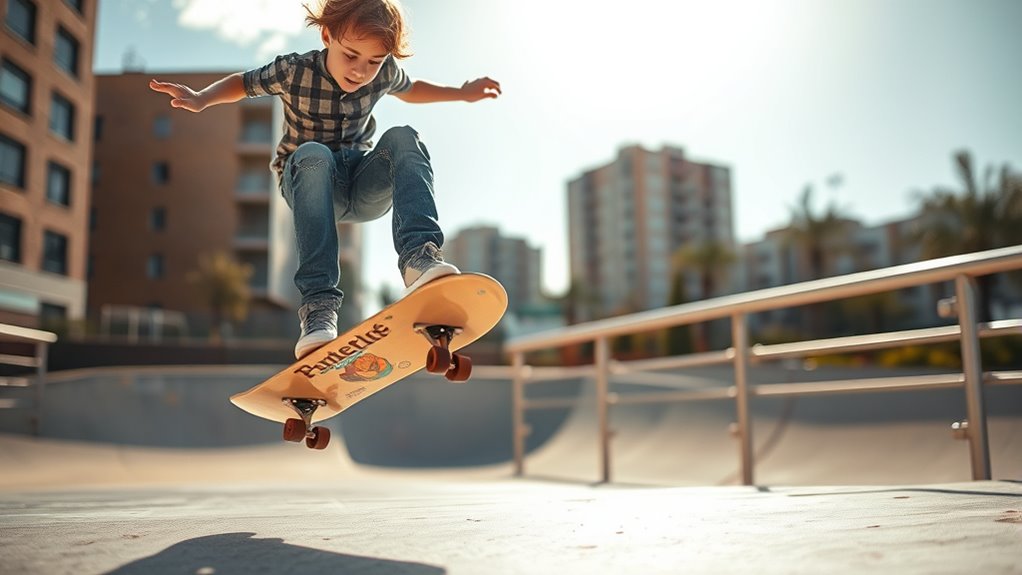
Mastering the timing of your bunny hop is essential for executing it smoothly and confidently. Proper timing guarantees you lift the front wheel at the right moment, making the hop seamless. To improve your timing, focus on:
- Consistently checking your bike maintenance to assure responsive handling
- Practicing trail navigation to anticipate obstacles that require quick hops
- Synchronizing your pedal stroke with your body’s upward movement
Curbing fear comes down to building trust in your bike and yourself. Start small, practice on familiar terrain, and gradually increase difficulty. Remember, confidence grows with repetition. As you refine your timing, you’ll feel more in control, making trail navigation easier and safer. Overcoming hesitation allows you to enjoy riding more and master the bunny hop with ease.
The Step-by-Step Technique Breakdown
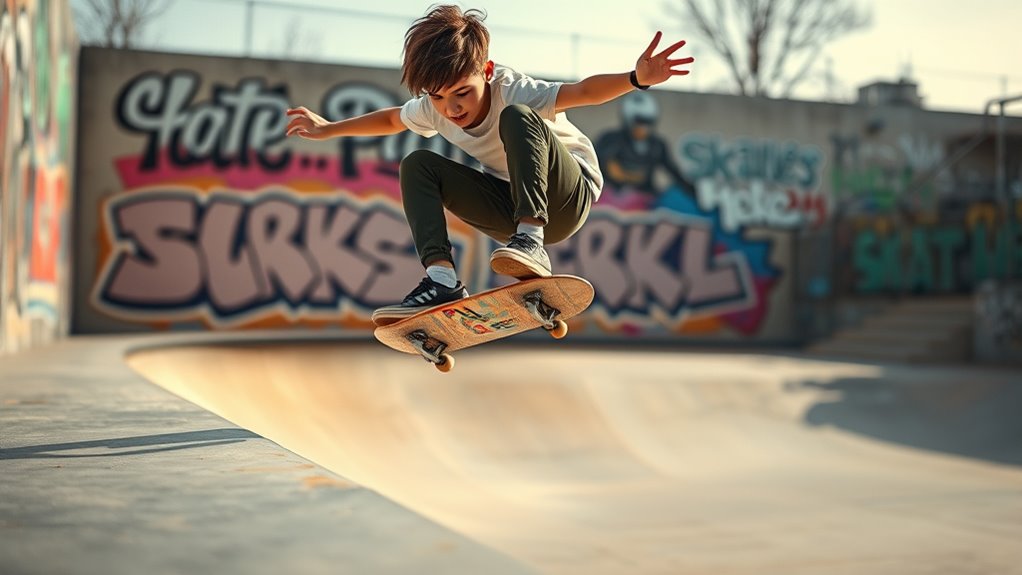
Breaking down the bunny hop into clear, manageable steps makes learning it much easier. Start by ensuring your bike is well-maintained; check tire pressure, brake function, and chain tension for riding safety. Begin with a small rider weight shift backward as you lift the front wheel by pulling up on the handlebars. Simultaneously, bend your knees and prepare to lift the rear wheel by pulling up with your legs. As the front lifts, shift your weight forward slightly to level the bike. Then, pull up your legs and tuck the bike beneath you, using your hips to propel the hop. Practice each step slowly, focusing on balance and timing. Proper bike maintenance and safety are essential for confidence and control during this process.
Using Your Arms and Legs Effectively
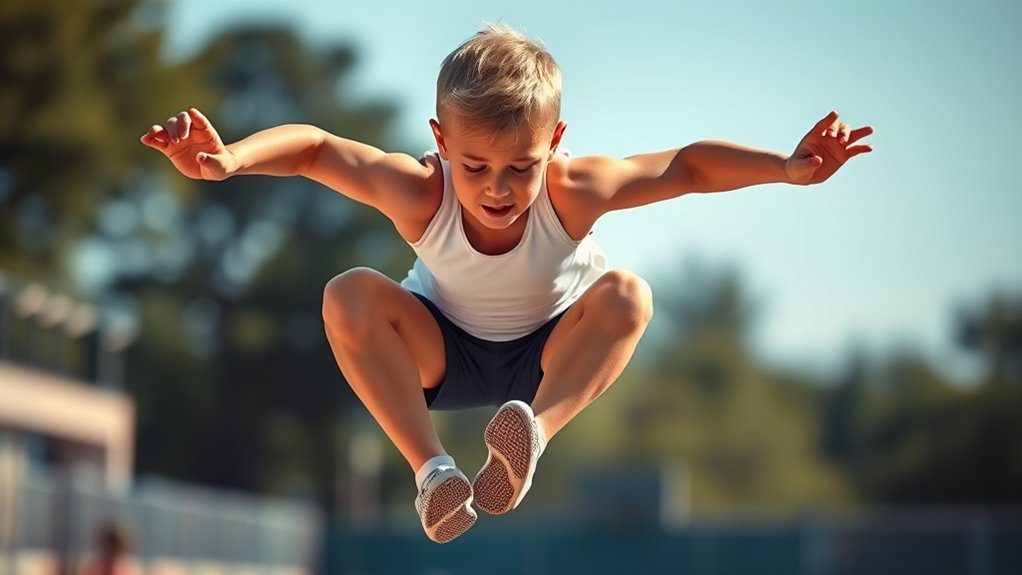
To improve your bunny hop, focus on coordinating your arm swing and leg push for maximum lift. You should also maintain body tension to stay balanced and control your movement. Getting these elements right will help you jump higher and land smoothly.
Coordinate Arm Swing
Coordinating your arm swing with your legs is essential for a smooth and efficient bunny hop. Good arm swing harmony helps you maintain momentum control and ensures a seamless lift-off. Focus on timing your arm movement to match your legs’ upward motion, creating a fluid, synchronized motion. To improve this coordination:
- Keep your arms relaxed but active, swinging naturally with your legs.
- Use your arms to generate upward momentum, helping lift your bike.
- Maintain a steady rhythm to prevent uneven or jerky movements.
Leg Push Power
Have you ever wondered how to maximize your leg push power during a bunny hop? Your leg push power is vital for mastering bunny hop mechanics, giving you the lift needed to clear obstacles smoothly. To do this, focus on driving through your legs with explosive strength as you crouch down. Use your arms to help generate momentum, but remember, your legs are the primary force. Engage your thigh muscles and push off the ground forcefully, extending your hips and knees quickly. Keep your feet firm on the pedals and coordinate your leg drive with your arm swing for maximum lift. Improving your leg push power takes practice, but by emphasizing explosive, controlled movements, you’ll notice a significant boost in your bunny hop performance.
Maintain Body Tension
Maintaining body tension is essential for a successful bunny hop, as it keeps your movements controlled and efficient. When you focus on core engagement and muscle control, you can better stabilize your body during each phase. This stability allows for a smooth progression from takeoff to landing, reducing wobbling or loss of balance. To achieve this, keep your arms slightly bent and engaged, and tighten your core muscles to support your spine. Your legs should stay active, with muscles ready to absorb impact and generate lift. Remember to:
- Keep your arms firm but flexible to control your front end
- Engage your core to stabilize your torso
- Maintain leg muscle tension for power and control
This combination ensures your body remains taut, giving you the precision needed for a clean bunny hop every time.
Practicing the Pull-Up and Tuck Motion
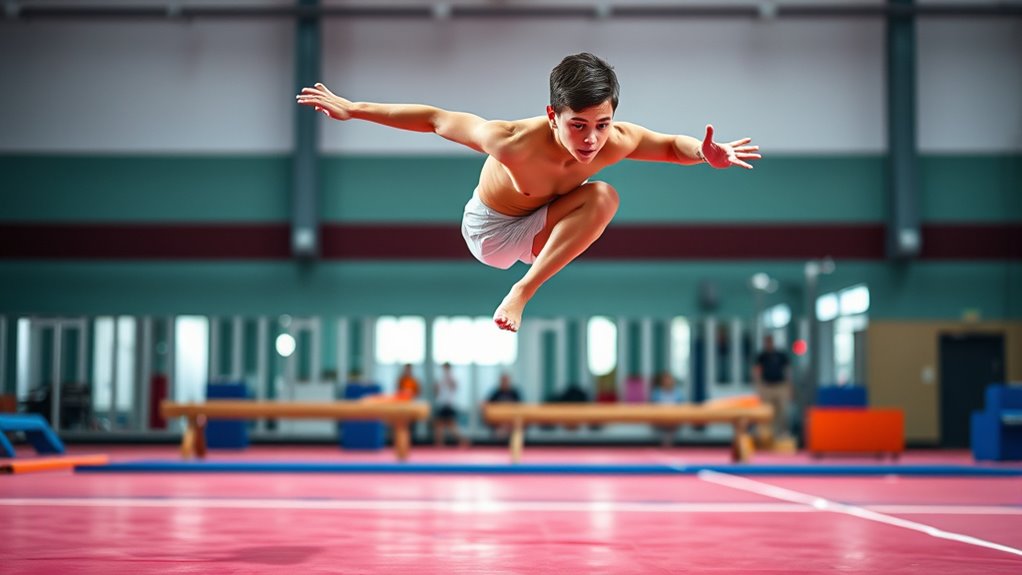
To master the bunny hop, you need to perfect the pull-up and tuck motion, which are essential components of the jump. Focus on practicing different pull-up variations to build strength and control. Incorporate tuck position drills to improve your ability to bring your knees toward your chest smoothly. Start by hanging from a bar or sturdy surface and pull yourself up while engaging your core. As you lift, tuck your knees tightly to your chest, then extend your legs back out. Repeating these drills helps you develop the muscle memory needed for a clean bunny hop. Consistent practice will enhance your coordination between pulling and tucking, making your jumps more controlled and powerful without the need for a coach.
Adding Height and Distance Gradually

Once you’ve become comfortable with the pull-up and tuck motion, start focusing on adding height and distance gradually. Progress carefully to build confidence and control. Before each session, verify your bike is well-maintained to prevent surprises, and always wear your safety gear. To improve, consider these tips:
- Practice small hops first, increasing height as you master balance
- Use controlled pedal strokes to generate momentum
- Keep your focus ahead to maintain proper body positioning
Troubleshooting Common Mistakes

If your bunny hops aren’t smooth, you might be misjudging your body position or timing. Keeping your body aligned and coordinating your movements can make a big difference. Let’s look at common mistakes and how to fix them so you can hop like a pro.
Improper Body Positioning
Improper body positioning can considerably hinder your bunny hop success, causing you to lose balance or fail to clear obstacles. Poor body alignment often results in instability, while incorrect hand positioning affects control and power transfer. To improve, focus on maintaining a neutral spine and centered weight over your bike. Guarantee your arms are slightly bent, with hands positioned comfortably on the handlebars for ideal leverage. Pay attention to these key points:
- Keep your body aligned over the frame, avoiding leaning too far forward or back
- Position your hands correctly on the handlebars for balance and control
- Engage your core to stabilize your body during the hop
Mastering body positioning helps you generate the right momentum and stay balanced, making your bunny hops cleaner and more efficient.
Incorrect Timing and Rhythm
Incorrect timing and rhythm are common mistakes that can sabotage your bunny hop efforts. If you’re not syncing your movements properly, your jump won’t be smooth. Use visual cues like watching your bike’s suspension compress and rebound to time your pedal pull and body lift. Auditory signals, such as the sound of your tires hitting the ground or the squeak of your chain, can also guide your rhythm. Practice isolating these cues to develop a consistent pattern. Focus on a steady, rhythmic flow rather than rushing or hesitating. When your movements are in sync, the bunny hop becomes more natural and controlled. Remember, mastering timing is about listening to your bike and watching your body’s cues to create a seamless, fluid motion.
Frequently Asked Questions
How Long Does It Typically Take to Master the Bunny Hop?
You’re probably wondering how long it takes to master the bunny hop. It varies depending on your practice consistency and skill development, but most riders see progress within a few weeks. With regular practice, you’ll develop muscle memory and coordination faster. Stay patient, practice often, and focus on refining each part of the move. Over time, you’ll notice improvements, and mastering the bunny hop will become second nature.
Can I Learn Bunny Hops on Any Type of Bike?
Imagine trying to leap over a canyon on a tiny bike—sounds wild, right? You can learn bunny hops on most bike types, but some make skill transfer easier. Mountain bikes with sturdy frames and smooth suspension help build confidence, while BMX bikes are designed for tricks. Regardless of bike type, focus on technique, and you’ll transfer those skills across different bikes, making each ride more impressive and fun.
What Safety Gear Is Recommended for Practicing Bunny Hops?
When practicing bunny hops, you should always prioritize safety. Wear protective gloves to improve your grip and protect your hands from scrapes. A helmet safety is essential to shield your head during falls or accidents. Consider additional gear like knee and elbow pads for extra protection. This safety gear helps prevent injuries and builds your confidence, so you can focus on perfecting your bunny hop technique without worry.
Are There Beginner-Friendly Alternatives to Bunny Hops?
If you’re looking for beginner-friendly alternatives to bunny hops, there are plenty of options. You can try alternative techniques like manual wheel lifts or small hop drills to build your skills gradually. Focus on beginner drills that emphasize balance and control, such as practicing small jumps or mastering wheel lifts. These methods help you gain confidence and improve your technique without the complexity of full bunny hops, setting a solid foundation for more advanced tricks later.
How Do I Stay Motivated During the Learning Process?
Ever wonder how to stay motivated when progress stalls? It’s all about mental resilience and smart goal setting. Keep your eyes on the prize, breaking the learning process into small wins that boost your confidence. Remind yourself why you started, and don’t be afraid to celebrate every little victory. Stay committed, and you’ll find the motivation to push through even the toughest moments, turning setbacks into stepping stones.
Conclusion
Now you’re on the brink of conquering the bunny hop like a mountain goat on a trampoline! With your new skills, you’ll be soaring over obstacles faster than a superhero on a sugar rush. No longer will you fear the tiniest curb or crack—you’re about to turn every ride into an epic adventure where you defy gravity and leave your friends in awe. Get ready to hop, land, and rule the trails like a bouncing legend!



